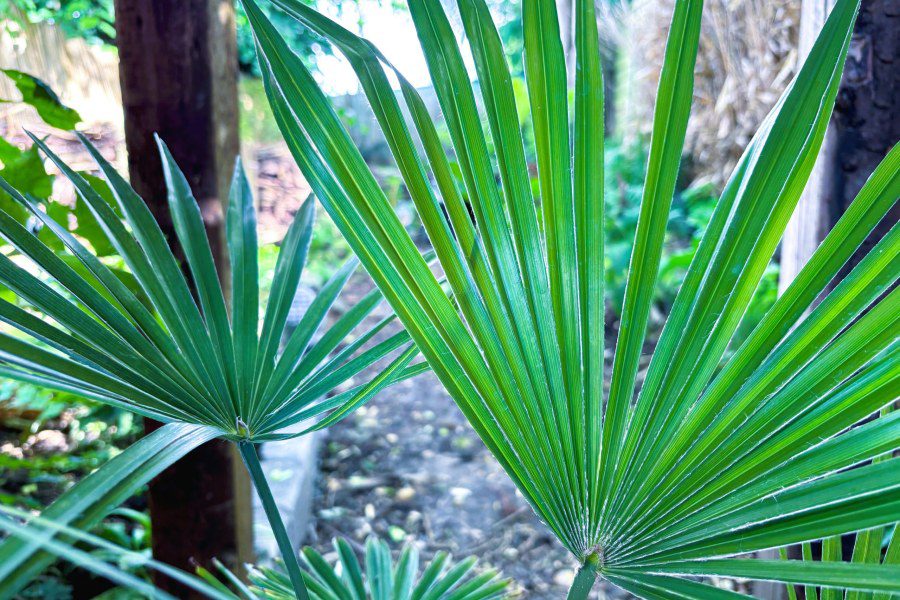Introduction to Trachycarpus fortunei x princeps Hybrid
The Trachycarpus fortunei x princeps hybrid is an intriguing blend of two robust and aesthetically appealing palm species: Trachycarpus fortunei (the Windmill Palm) and Trachycarpus princeps (the Stone Gate Palm). This hybrid combines the hardiness of T. fortunei with the striking blue-silver undersides of T. princeps leaves, making it a perfect choice for gardeners aiming to create a tropical oasis in the temperate UK climate.
Historical Background of Trachycarpus Palms
Trachycarpus fortunei, native to central and eastern China, has been cultivated in Europe since the mid-19th century. Its popularity grew due to its remarkable cold tolerance, allowing it to thrive in various climates outside its native range. Trachycarpus princeps, discovered in the rugged limestone mountains of Yunnan, China, is less common but admired for its distinctive blue-silver leaf undersides. The hybridization of these two species aims to combine the best traits of both, resulting in a palm that is both visually striking and resilient.
Advantages of Trachycarpus fortunei x princeps Hybrid
- Enhanced Aesthetics: The hybrid features the fan-shaped leaves of T. fortunei with the added beauty of the blue-silver undersides from T. princeps.
- Increased Hardiness: Combining the hardiness of T. fortunei with the unique characteristics of T. princeps, this hybrid is well-suited for temperate climates.
- Tropical Appeal: Its exotic appearance makes it a standout feature in tropical-style gardens, adding a touch of the tropics to UK gardens.
- Versatility: It can be grown in a variety of soil types and conditions, making it a versatile choice for many gardeners.
Cultivating Trachycarpus fortunei x princeps Hybrid in the UK
To successfully grow this hybrid palm in the UK, follow these detailed guidelines:
1. Selecting the Right Location
Choose a location that offers full sun to partial shade. While the hybrid is quite adaptable, providing ample sunlight ensures vigorous growth and healthy foliage. Ensure the site is sheltered from strong winds to protect the fronds from damage.
2. Soil Requirements
Trachycarpus fortunei x princeps prefers well-draining soil. Amend heavy clay soils with sand and organic matter to improve drainage and fertility. It can tolerate a range of soil pH levels but thrives best in slightly acidic to neutral soil.
3. Planting and Spacing
Plant the hybrid in spring to give it the entire growing season to establish roots. Dig a hole twice the width of the root ball and of equal depth. Place the palm in the hole, backfill with soil, and water thoroughly. Space multiple plants at least 1.5 to 2 meters apart to allow for their mature size.
4. Watering
Water the palm regularly during its first year to establish a strong root system. Once established, it is relatively drought-tolerant but benefits from regular watering during prolonged dry periods. Ensure the soil remains moist but not waterlogged.
5. Temperature and Hardiness
This hybrid is hardy down to -10°C to -12°C, making it suitable for most UK climates. In regions prone to severe frost, consider providing winter protection such as mulching around the base and covering the fronds with horticultural fleece.
6. Feeding
Feed the palm with a balanced, slow-release fertilizer in spring and midsummer to promote growth. A fertilizer formulated for palms or a general-purpose feed with an N-P-K ratio of around 10-10-10 is suitable.
7. Pruning and Maintenance
Prune dead or damaged fronds to maintain the palm’s appearance and health. Regularly remove old leaves close to the trunk to prevent pest infestations. Avoid over-pruning, as the leaves are crucial for the plant’s growth and energy production.
Designing a Tropical-Style Garden
Incorporating Trachycarpus fortunei x princeps into your tropical-style garden can create a lush, exotic atmosphere. Here are some design tips:
- Foliage Combinations: Pair with other tropical plants like Musa basjoo (hardy banana), Hedychium (ginger lilies), and Fatsia japonica for a layered, verdant look.
- Colorful Blooms: Add flowering plants such as Canna lilies, Bird of Paradise (Strelitzia), and Hibiscus for vibrant splashes of color.
- Water Features: Enhance the tropical ambiance with a water feature like a pond or a fountain, which can also help maintain humidity.
- Decorative Elements: Use bamboo fencing, tropical-themed ornaments, and comfortable seating areas to complete the exotic garden theme.
Conclusion
Growing Trachycarpus fortunei x princeps hybrid in the UK can bring a touch of the tropics to your garden. With its unique aesthetics, hardiness, and versatility, this hybrid palm is an excellent choice for creating a lush, tropical-style garden. By following proper planting and care guidelines, you can enjoy the exotic beauty of this palm in your own backyard. Embrace the challenge and let the Trachycarpus fortunei x princeps hybrid transform your garden into a tropical paradise. Happy gardening!


